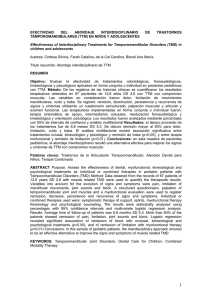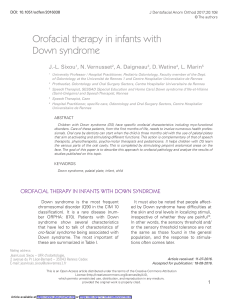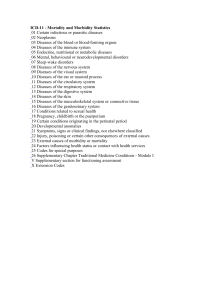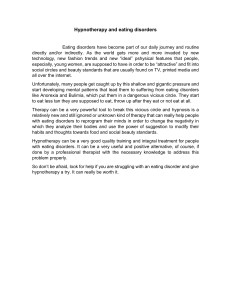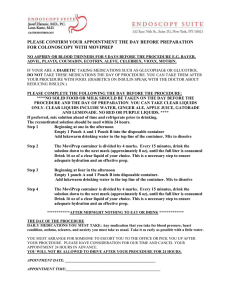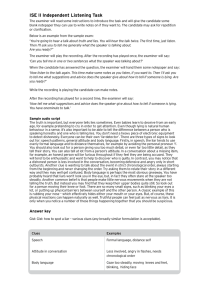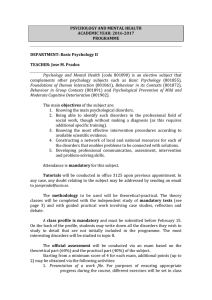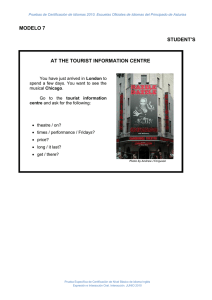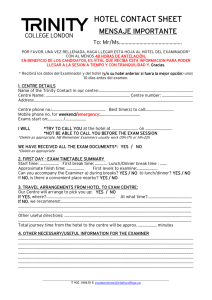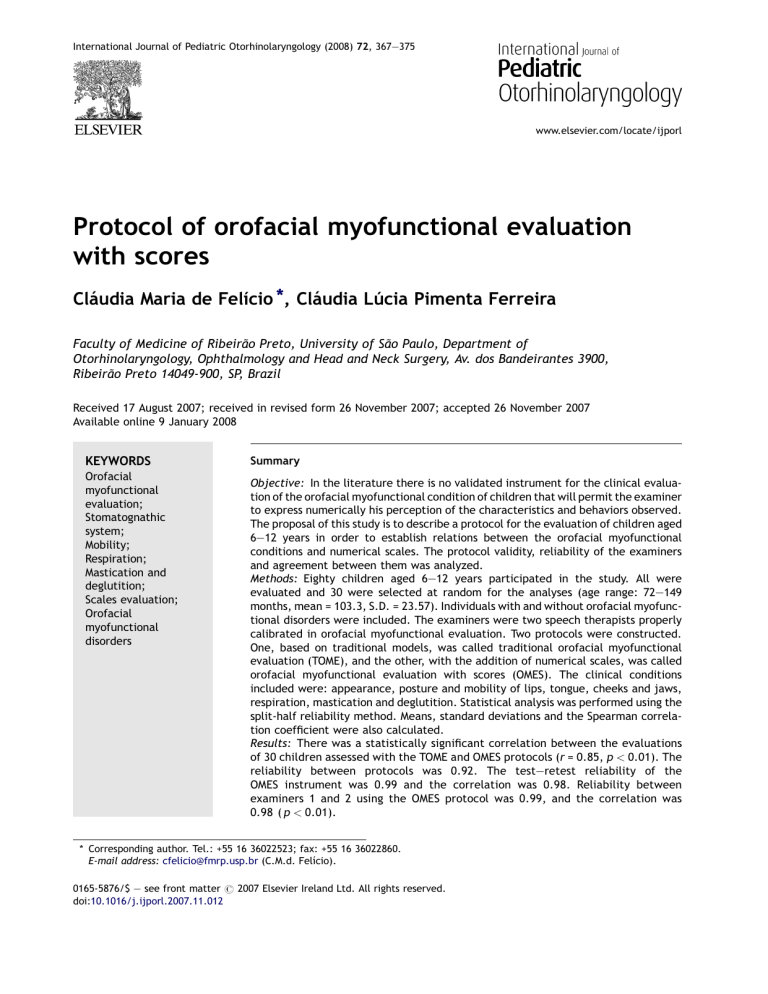
International Journal of Pediatric Otorhinolaryngology (2008) 72, 367—375 www.elsevier.com/locate/ijporl Protocol of orofacial myofunctional evaluation with scores Cláudia Maria de Felı́cio *, Cláudia Lúcia Pimenta Ferreira Faculty of Medicine of Ribeirão Preto, University of São Paulo, Department of Otorhinolaryngology, Ophthalmology and Head and Neck Surgery, Av. dos Bandeirantes 3900, Ribeirão Preto 14049-900, SP, Brazil Received 17 August 2007; received in revised form 26 November 2007; accepted 26 November 2007 Available online 9 January 2008 KEYWORDS Orofacial myofunctional evaluation; Stomatognathic system; Mobility; Respiration; Mastication and deglutition; Scales evaluation; Orofacial myofunctional disorders Summary Objective: In the literature there is no validated instrument for the clinical evaluation of the orofacial myofunctional condition of children that will permit the examiner to express numerically his perception of the characteristics and behaviors observed. The proposal of this study is to describe a protocol for the evaluation of children aged 6—12 years in order to establish relations between the orofacial myofunctional conditions and numerical scales. The protocol validity, reliability of the examiners and agreement between them was analyzed. Methods: Eighty children aged 6—12 years participated in the study. All were evaluated and 30 were selected at random for the analyses (age range: 72—149 months, mean = 103.3, S.D. = 23.57). Individuals with and without orofacial myofunctional disorders were included. The examiners were two speech therapists properly calibrated in orofacial myofunctional evaluation. Two protocols were constructed. One, based on traditional models, was called traditional orofacial myofunctional evaluation (TOME), and the other, with the addition of numerical scales, was called orofacial myofunctional evaluation with scores (OMES). The clinical conditions included were: appearance, posture and mobility of lips, tongue, cheeks and jaws, respiration, mastication and deglutition. Statistical analysis was performed using the split-half reliability method. Means, standard deviations and the Spearman correlation coefficient were also calculated. Results: There was a statistically significant correlation between the evaluations of 30 children assessed with the TOME and OMES protocols (r = 0.85, p < 0.01). The reliability between protocols was 0.92. The test—retest reliability of the OMES instrument was 0.99 and the correlation was 0.98. Reliability between examiners 1 and 2 using the OMES protocol was 0.99, and the correlation was 0.98 ( p < 0.01). * Corresponding author. Tel.: +55 16 36022523; fax: +55 16 36022860. E-mail address: [email protected] (C.M.d. Felı́cio). 0165-5876/$ — see front matter # 2007 Elsevier Ireland Ltd. All rights reserved. doi:10.1016/j.ijporl.2007.11.012 368 C.M. Felı́cio, C.L.P. Ferreira Conclusion: The OMES protocol proved to be a valid and reliable instrument for orofacial myofunctional evaluation, permitting the grading of orofacial myofunctional conditions within the limits of the selected items. # 2007 Elsevier Ireland Ltd. All rights reserved. 1. Introduction The oral motor system is traditionally evaluated by speech therapists and by other health professionals both when speech is the main complaint and in specific cases of orofacial myofunctional disorder. Orofacial myofunctional disorders include specific conditions or behaviors that can have a negative impact on oral postures and functions [1]. Tongue thrusting, deviate swallowing, mouth breathing, orofacial muscle imbalance, deviate mandibular movement are the most important orofacial dysfunctions underlying disorders of articulation [2]. Several authors have defined procedures for such evaluation [1,3—14] and revised previously proposed procedures [15—17]. The objective of using protocols for evaluation is to establish parameters that will permit the study of a case for the definition of treatment and for later determination of the outcomes [8]. When we record data on a protocol we can detect a configuration or certain regularities that lead us to identify certain categories of known problems [12]. The data of an evaluation can be recorded by means of detailed descriptions or by semantic qualitative analysis; however, quantitation of the data may be necessary, especially for research purposes. In the literature, except for The Nordic Orofacial Test-Screening (NOT-S), which involves a structured interview and clinical examination for the screening of orofacial dysfunction [18], there is no validated instrument for the clinical evaluation of orofacial structures and functions of children that will permit the examiner to express numerically his perception of the characteristics and behaviors observed, i.e., an instrument that will permit the measurement of the impressions of the clinician. Also, intra- and inter-examiner reliability has not been widely explored regarding orofacial myofunctional evaluation and, as pointed out by McCullough et al. [19], without this analysis the usefulness of clinical measures may be questioned. Thus, the objective of the present study was to describe a protocol for the evaluation of children aged 6—12 years in order to establish relations between numerical scales and the orofacial myofunctional conditions, i.e., physical characteristics and orofacial behaviors. The proposed protocol may be administered within a short period of time and does not require the use of special measuring equip- ment. The validity of the protocol, the reliability of the examiners and agreement between them were analyzed. 2. Material and methods 2.1. Subjects The project was approved by the Human Research Ethics Committee of the Institution and all subjects gave written informed consent to participate. Eighty consecutive children on the university waiting list for various treatments, aged 6—12 years, whose specific complaint was not a communication or orofacial myofunctional disorder, participated in the study (mean age = 104.35 months). Thirty of them were selected at random using the GraphPad Software, for validity analyses (age range: 72—149 months, mean = 103.3, S.D. = 23.57). Individuals with and without orofacial myofunctional disorders were included since several degrees of alteration, as well as normal standards were needed for scale construction. Orofacial myofunctional disorders were defined as alterations/dysfunctions of the appearance, posture and/or mobility of the lips, tongue, mandible and cheeks and of respiration, deglutition and mastication functions. Individuals with hearing loss, mental retardation, neurological or emotional disorders were excluded. 2.1.1. Examiners Two speech therapists properly calibrated in orofacial myofunctional evaluation. Examiner 1 (C.M.F.), a speech pathologist and professor of orofacial myofunctional therapy, prepared examiner 2 for orofacial myofunctional evaluation before the study during teaching and research activities and concordance between them was previously tested. 2.2. Procedures 2.2.1. Definition of the clinical methodology for orofacial myofunctional evaluation The methods for the evaluation of structure and function were defined before data collection based on a literature survey [3—14,16,17]. The items that appeared more frequently in the publications consulted were included as follows: aspect/ OMES protocol appearance/posture of lips, jaws, cheeks, face, tongue and palate, mobility of lips, tongue, jaws and cheeks, and functions–—respiration, deglutition and mastication. The protocol for evaluation based on traditional models was called traditional orofacial myofunctional evaluation (TOME). 2.2.2. Elaboration of the protocol with a numerical scale A protocol was constructed based on same previous models of evaluation, with the addition of numerical scales that would reflect the physical characteristics and orofacial behaviors of the subjects. This protocol was called orofacial myofunctional evaluation with scores (OMES) (Appendix A). 2.2.3. Data collection The children were evaluated individually (orofacial myofunctional evaluation) by visual inspection during the session and the evaluation was later complemented by the analysis of images recorded on videocassette (JVC model GR-AX720 movie camera and JVC 8 mm cassettes). For the evaluation of mobility, the children were asked to perform separate movements of the lips, tongue, jaws, and cheeks. In the analysis, separate movements of each component, precise and without tremors, were considered to be normal. Dysfunction was considered to be present when lack of precision in the movement, tremor, associated movements of other components (e.g., lips accompanying the movements of the tongue) and inability to perform the movement were observed. Using the OMES Protocol, the examiner attributed scores on a 3 point scale: 3 = normal, 2 = insufficient ability, and 1 = absence of ability or being unable to perform the task. Complementing the analysis, for jaw movements, extension measurements (in mm) were also considered and carried out using a Mitutoyo caliper. 2.3. Functions For respiration, the pattern was considered to be nasal when the subject presented labial closure without effort during rest. For deglutition, the pattern was considered to be normal when the subject presented the tongue contained in the oral cavity, contraction of elevator muscles, and anterior sealing of the oral cavity without effort. For mastication, the subject was instructed to chew the food (a stuffed cookie) in his habitual manner. In the analysis of images recorded on video, the following parameters were considered: chewing, whether alternated bilateral, simultaneous bilateral, chronic unilateral (95% of the time on 369 the same side of the oral cavity), or anterior; unilateral chewing preference (66% of the time on the same side), or anterior, and total time needed to consume the food measured with a Cronobios digital chronometer [8,9,17]. In addition to being described in the specific protocol, chewing and deglutition functions were scored as normal (3), mild dysfunction (2), or severe dysfunction (1). Other behaviors were defined as normal when they received a score of 2 and altered when they received a score of 1. The same children were evaluated by examiner 2, who used the TOME. For the analysis of inter-examiner reliability both examiners used the OMES. 2.4. Statistical analysis For statistical analysis the results of the TOME protocol were transformed to numerical values, with a value of 2 being attributed to normal results and a value of 1 to altered results. For chewing behavior, the values were as follows: alternated bilateral chewing = 4, bilateral simultaneous = 3, unilateral preference = 2, and chronic unilateral = 1. The data obtained by the evaluation of 30 subjects were used for the validation of the OMES protocol. The OMES and TOME protocols were then compared. The validity [20] and reliability of the instrument was analyzed according to the criteria described [21]. The data used for the validation of the protocol (test) and obtained from the selected subgroups (20% of the samples) were used to test the reliability of the instrument — test—retest — and the examiners conducted new analyses of the videos of these subjects, each using the protocol of the first evaluation (retest). The test—retest reliability was also calculated for the TOME protocol because of the lack of a validated protocol for orofacial myofunctional evaluation that would contain all the items considered in the present study. An additional 20% of the sample was re-evaluated on the basis of the videos for the analysis of interexaminer reliability when both used the OMES in order to determine inter-examiner agreement regarding application and/or interpretation. A 6-month interval was scheduled, on average, for the second evaluation in order to avoid memory effects on the results. The images recorded on video were used for this purpose. Thus, the items that required live observation, such as jaw movement extension measurements (in mm) and palate configuration (appearance) were not analyzed in this phase. Statistical analysis was performed using the Statistics software based on the split-half reliability method. Means, standard deviations and the Spear- 370 man correlation coefficient were also calculated. The level of significance was set at p < 0.05. 3. Results 3.1. Validation of the OMES protocol There was a statistically significant correlation between the evaluations of 30 children assessed with the TOME and OMES protocols (r = 0.85, p < 0.01). The reliability between protocols was 0.92. The following significant correlations were observed between the data obtained with the TOME and OMES protocols: posture/appearance of the lips (r = 0.59), of the cheeks (r = 0.55), of the face (r = 0.65), and of the hard palate (r = 0.37); mobility of the lips (r = 0.56), tongue (r = 0.46), cheeks (r = 0.61), jaws (visual inspection) (r = 0.54), and measures in mm — opening (r = 0.71), right laterality (r = 0.66), left laterality (r = 0.66), and protrusion (r = 0.83); Functions — breathing (r = 0.56), deglutition and tongue behavior (r = 0.76), and type of chewing (r = 0.77). The p-values ranged from 0.001 to 0.05. 3.1.1. Reliability of the OMES instrument The test—retest reliability of OMES (examiner 1) was 0.99. The test—retest correlation was 0.98. The following results were obtained in the test: mean = 138.24, sum = 829.47, standard deviation = 27.11, and variance = 735.11. In the retest the results were: mean = 136.07, sum = 816.43, standard deviation = 28.20, and variance = 795.06. 3.1.2. Reliability of the TOME instrument The test—retest reliability of TOME (examiner 2) was 0.98. The test—retest correlation was 0.98. The following results were obtained in the test: mean = 99.78, sum = 598.67, standard deviation = 24.44, and variance = 597.29. In the retest the results were: mean = 104.70, sum = 628.20, standard deviation = 33.15, and variance = 1098.96. Reliability between Examiners 1 and 2 using the OMES protocol was 0.99, and the correlation was 0.98. The following results were obtained: examiner 1, mean = 151.38, sum = 908.27, standard deviation = 17.28, and variance = 298.63. Examiner 2: mean = 156.15, sum = 936.88, standard deviation = 18.82, and variance = 354.21. C.M. Felı́cio, C.L.P. Ferreira mentioned in the literature [3—14,16,17] consulted were selected for the elaboration of the TOME and OMES Protocols. The psychophysical methodology [22] was used for the development of the OMES protocol since it has been extensively used for the scaling of social and clinical attributes, among them the subjective sensation of dyspnea, the perception of difficulty of pronounciability (articulation difficulty), and the perception of speech and voice. Although the use of the ratio scale has been defended [23], in the present study we opted for a numerical interval scale. Several authors have previously defined the aspects to be evaluated in an investigation of myofunctional disorders [3—14,16,17], as well as the protocols [8,12], and have attempted to transform semantic descriptions into numerical data [3,5,10,11,13,14,16]. However, the score ranges from zero to (1), with no grading for each item. The validity of an instrument can be defined as its real capacity to measure what it proposes to measure [24] and the validation of an instrument is performed by comparing it to a previously existing external criterion, generally with the use of statistical methods. The gold standard often is the clinical diagnosis or some type of criterion previously established as a reference standard [20,21]. The OMES protocol proved to be valid for orofacial myofunctional evaluation since there was correlation and concordance of the results with the TOME. Also, it was found to be a reliable instrument when multiple applications were compared (test— retest), with reliability between examiners [25— 27]. Indeed, without this analysis, the usefulness of clinical measurements may be questioned [19]. 5. Conclusion The OMES protocol proved to be a valid and reliable instrument for orofacial myofunctional evaluation that can be administered without special equipment and in a brief manner, permitting the grading of specific orofacial myofunctional disorders within the limits of the selected items. 6. Conflict of interest statement None. 4. Discussion Acknowledgment A review of protocols for orofacial myofunctional disorders was completed prior to developing the protocols. Items and tests that are more frequently This work was supported in part by Conselho Nacional de Pesquisa (CNPq) do Ministério da Ciência e Tecnologia do Brazil. OMES protocol Appendix A 371 372 Appendix A (Continued ) C.M. Felı́cio, C.L.P. Ferreira OMES protocol Appendix A (Continued ) 373 374 C.M. Felı́cio, C.L.P. Ferreira Appendix A (Continued ) References [11] [1] R.M. Mason, Retrospective and prospective view of orofacial myology, Int. J. Orofacial Myology 31 (2005) 5— 14. [2] W. Bigenzahn, L. fischman, U. Mayrhofer-Kramme, Myofunctional therapy in patients with orofacial dysfunctions affecting speech, Folia Phoniatr. 44 (1992) 238—244. [3] J. Robbins, T. Klee, Clinical assessment of oropharingeal motor development in young children, J. Speech Hear. Disord. 52 (1987) 271—277. [4] J.P. Duffy, Motor Speech Disorders: Substrates, Differential Diagnosis and Management, Mosby, St. Louis, 1995, 467 p.. [5] I.C.R.P. Guimarães, Orofacial Asssessment Protocol, Lisboa, Eupraxis, 1995, 55 p. (Portuguese). [6] F.C.B. Neiva, H.F. Wertzner, A protocol for oral myofunctional asssessment: for application with children, Int. J. Orofacial Myology 22 (1996) 8—19. [7] E.M.G. Bianchini, Speech-pathologist evaluation: orofacial myofunctional disorders or compensatory situation, Dental Press Orthodox. Or top. Facial 6 (2001) 73—82. [8] C.M. Felı́cio, Temporomandibular disorder: evaluation and clinical cases, in: P. Junqueira, M.T.B.C. Dauden (Eds.), Current Aspects in Speech Therapy, São Paulo, Pancast, 2002 , pp. 33—63 (Portuguese). [9] C.M. Felı́cio, M.O. Mazzetto, C.P.A. Dos Santos, Masticatory behavior in individuals with temporomandibular disorders, Minerva Stomatol. 51 (2002) 111—120. [10] S.R. Aurélio, K.F. Genaro, E.D. Macedo Filho, Comparative analysis of swallowing patterns between children with cer- [12] [13] [14] [15] [16] [17] [18] ebral palsy and normal children, Rev. Bras. Otorrinolaringol. 68 (2002) 167—173. S.R.V. Hage, Speech-pathologist asssessment in children without orality, in: I.Q. Marchesan, J.L. Zorzi (Eds.), Tópicos em fonoaudiologia, Revinter, Rio de Janeiro, 2003 , pp. 175—185 (Portuguese). I.Q. Marchesan, Protocol for oral myofunctional asssessment, in: L.H. Krakauer, di francesco r c, I.Q. Marchesan (Eds.), Mouth breathing, Pulso, São José dos Campos, 2003, pp. 55—79 (Portugues). V.V. Degan, R.M. Puppin-Rontani, Removal of sucking habits and myofunctional therapy: establishing swallowing and tongue rest position, Pró-Fono R. Atual. Cient. 17 (2005) 375—382. F.C. Valera, L.V.V. Trawitzki, W.T. Anselmo-Lima, Myofunctional evaluation after surgery for tonsils hypertrophy and its correlation to breathing pattern: a 2-year-follow up, Int. J. Pediatr. Otorhinolaryngol. 70 (2006) 221—225. L. Paskay, Instrumentation and measurement procedures in orofacial mycology, Int. J. Orofacial Myology 32 (2006) 37— 57. F.C. Barros, C.M. Felı́cio, C.L.P. Ferreira, Speech motor control: theory and assessment tasks, Rev. Soc. Brasil Fonoaudiol. 11 (2006) 163—169. C.M. Felı́cio, M.O. Melchior, M.A.M. Rodrigues da Silva, R.M.S. Celeghini, Masticatory performance in adults related to temporomandibular disorder and dental occlusion, PróFono R. Atual. Cient. 19 (2007) 137—236. M. Bakke, B. Bergendal, A. Macalister, L. Sjögreen, P. Asten, Development and evaluation of comprehensive screening for orofacial dysfunction, Swed. Dent. J. 31 (2007) 75—84. OMES protocol 375 [19] G.H. McCullough, R.T. Wertz, J.C. Rosenbek, R.H. Mills, K.B. Ross, J.R. Ashford, Inter- and intrajudge reliability of a clinical examination of swallowing in adults, Dysphagia 15 (2000) 58—67. [20] J. Pehling, E. Schiffman, J. Look, J. Shaefer, P. Lenton, J. Fricton, Interexaminer reliability and clinical validity of the temporomandibular index: a new outcome measure for temporomandibular disorders, J. Orofacial Pain 16 (2002) 296—304. [21] P.R. Menezes, Validity and reliability of psychiatric rating scales, Rev. Psiquiatria Clı́nica 25 (1998) 214—216. [22] S.S. Stevens, Psychophysics: Introduction to its Perceptual, Neural, and Social Prospects, A Wiley-Intersience Publication, New York, 1975, 329 p.. [23] F.F. Sousa, R. Kamizaki, J.A. Da Silva, Social and clinical psychophysics: theory and applications, Psychologica 28 (2001) 233—242. [24] M.L.O.S. Formigoni, S. Castel, Rating scales of drug dependence: general aspects, Rev. Psiquiatria Clı́nica 26 (1999) 5— 39. [25] R.M.A. Fabbri, M.A. Moreira, R. Garrido, O.P. Almeida, Validity and reliability of the portuguese version of the confusion assessment method (CAM) for the detection of delirium in the elderly, Arq. Neuro-Psiquiatr. 59 (2001) 175—179. [26] S.F. Dworkin, J. Sherman, L. Mancl, R. Ohrbach, L. Leresche, E. Truelove, Reliability, validity, and clinical utility of the research diagnostic criteria for temporomandibular disorders axis II scales: depression, non-specific physical symptoms, and graded chronic pain, J. Orofac. Pain 16 (2002) 207—220. [27] H.L. Cintas, K.L. Siegel, G.P. Furst, L.H. Gerber, Brief assessment of motor function: reliability and concurrent validity of the gross motor scale, Am. J. Phys. Med. Rehabil. 82 (2003) 33—41. Available online at www.sciencedirect.com
